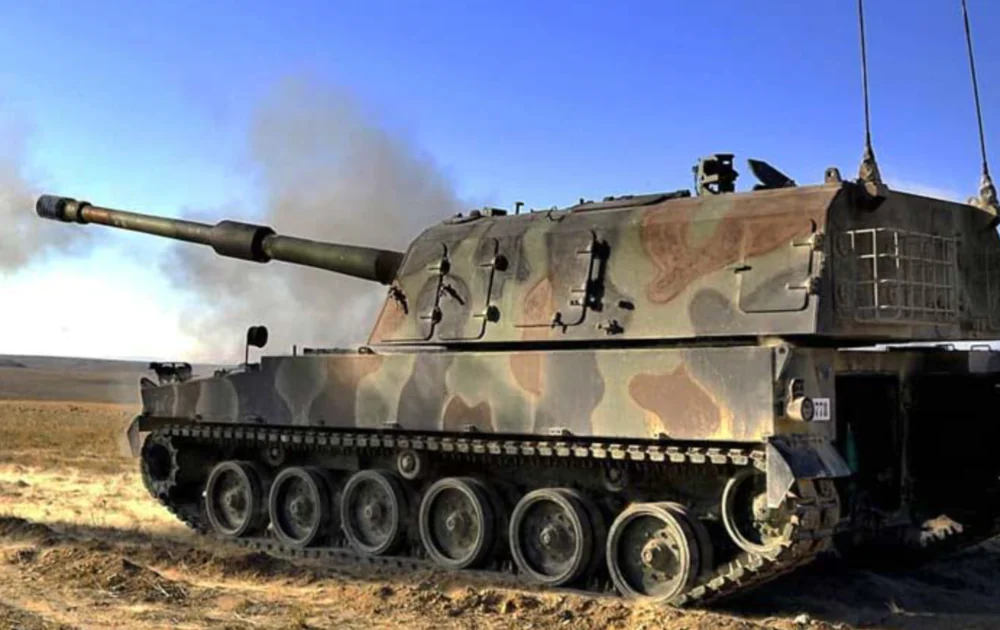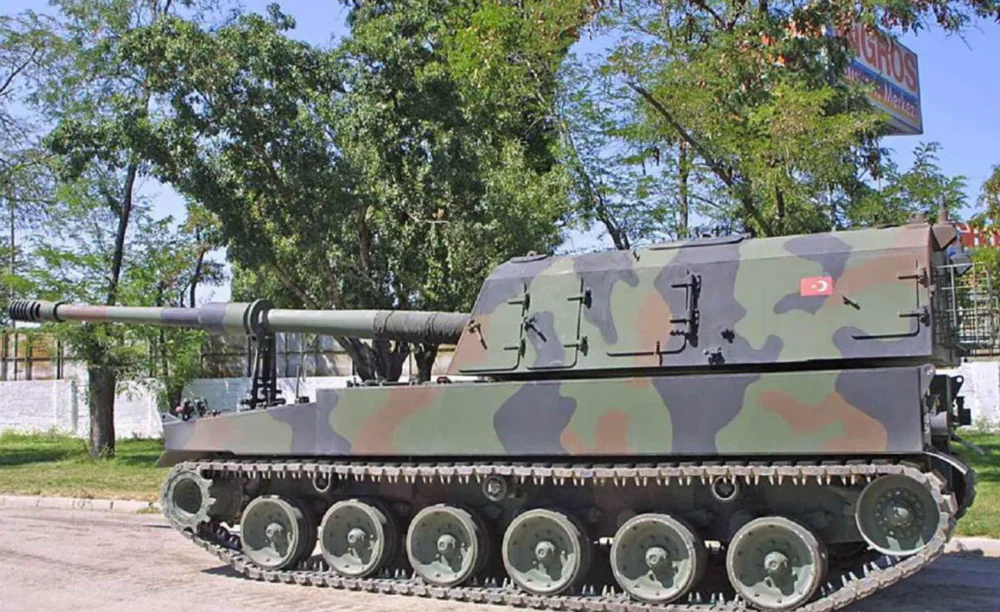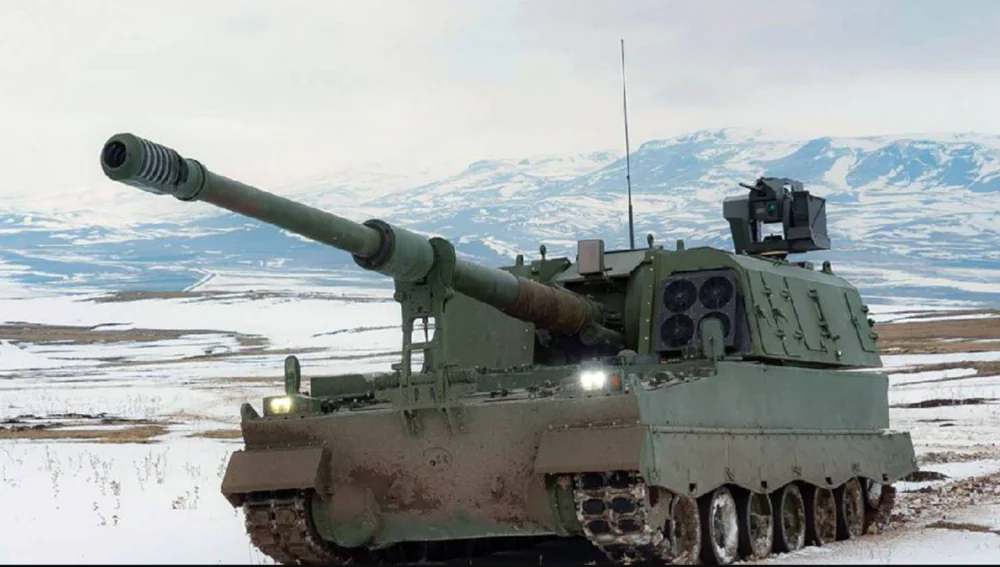© ROOT-NATION.com - Use of content is permitted with a backlink.
Turkey has always helped Ukraine in its fight against the Russian aggressor. Today, we will talk about the Turkish T-155 Firtina tracked self-propelled gun system.
There has been talk for a long time that the Ukrainian Armed Forces will soon be equipped with a new powerful self-propelled artillery system, the T-155 Firtina. Our defenders are eagerly awaiting this powerful weapon. This weapon will help us at the frontline, enabling us to hit enemy tanks, armoured vehicles, as well as strongholds and other targets. Let’s take a closer look at the Turkish T-155 Firtina tracked self-propelled guns.

Read also: Weapons of Ukrainian Victory: Modern PzH 2000 self-propelled howitzers
What is interesting about the T-155 Firtina
The T-155 Firtina (Storm) self-propelled howitzer is a modified Turkish version of the Korean K9 Thunder. It uses licensed K9 subsystems, such as the gun system and loading mechanism.
According to open sources, the Turkish Army has almost 1,100 self-propelled artillery systems of various types in service. One of the most numerous examples of such equipment is the T-155 Fırtına self-propelled artillery system. This self-propelled vehicle was developed on the basis of a foreign combat vehicle, which was brought into line with the needs of the Turkish army and the capabilities of the industry. The Turkish army currently has more than 100 howitzers of this type in service. Some sources claim that by 2023, Turkey will have purchased 280 howitzers for domestic use. According to other sources, Turkey has more than 300 of these howitzers. This makes them the most massive modern self-propelled artillery in the Turkish army.

The T-155 Firtina self-propelled gun is equipped with a 155 mm/L52 cannon. It has an automatic projectile handling system and a ram. The vehicle is compatible with standard NATO 155 mm ammunition. The maximum range of the M107 high-explosive projectile is 18 km, the M549A1 high-explosive projectile is 30 km, and the ERFB(BB) rocket projectile is up to 40 km.
Read also: All about the 155mm M777 howitzer and M982 Excalibur guided projectile
The history of the T-155 Firtina air defence system
The development of the T-155 Firtina began at the turn of the nineties and twenty-first century. At the end of the last century, the Turkish command thought about the need to create or purchase a new model of 155 mm self-propelled howitzer. Such a combat vehicle was to replace the hopelessly outdated foreign-designed models created in the middle of the century. It soon became clear that Turkey’s industry would not be able to cope with the task of independently developing the required model.
A successful way out of this situation was considered to be the acquisition of a licence to manufacture a foreign self-propelled vehicle. After studying the available proposals, the Turkish military chose the K9 Thunder self-propelled vehicle from the South Korean company Samsung Techwin. It was about building a modified combat vehicle. Turkey made some changes to the design of the original model and replaced some of the on-board equipment. All of these improvements were aimed at using components of Turkey’s own production.

In 2001, Turkey and South Korea signed an agreement to launch the production of modified self-propelled guns for the Turkish army. In the same year, the first two prototypes were built and tested. The modified K9 self-propelled vehicle was designated T-155 Firtina in Turkey. In 2002, this self-propelled vehicle was adopted by the Turkish army and its serial production was launched. According to the bilateral agreement, the first production vehicles were built by the Korean side, and the rest were produced by the Turkish industry. The licence for the production of the equipment cost Turkey $1 billion, but this rather large sum of money was worth it.
In total, the customer received 20-25 machines every year. Until 2017, the new equipment was built according to the original design, and later the production of updated self-propelled vehicles called Firtina 2 was launched.

The Firtina 2 upgrade project was developed based on the experience of combat use of the vehicle during recent military conflicts. It includes some upgrades to the electronic systems and the introduction of several new products. Improvements to the fire control system and loading automation have resulted in a certain increase in rate of fire, range and accuracy. Safety and crew comfort have also been improved.
The turret of the improved self-propelled gun was fitted with a remote-controlled combat module with an M2HB machine gun. Combat experience has shown that the machine gunner is exposed to significant risks when firing and therefore should not leave the protected space. It was also found that the unfavourable climate in the crew compartments makes it difficult for them to work. To maintain comfortable conditions, the vehicle was equipped with an air conditioner. Its external unit with heat exchangers and fans is located on the frontal part of the turret, to the left of the gun.
According to available data, the new T-155 self-propelled artillery systems are being built to an improved design. The existing vehicles will undergo a similar upgrade in the future. The timeline for upgrading the fleet to Firtina 2 is unknown.
Read also: Weapon of Ukrainian victory: American cluster munitions
Design features of the T-155 Firtina air defence system
The Turkish T-155 Firtina tracked self-propelled vehicle, like the K9 Thunder, is designed according to the traditional scheme for such vehicles. The vehicle is based on an armoured tracked chassis, on which a full-rotating turret with weapons is mounted. The hull and turret are welded from armour plates to provide protection against small arms. The vehicle is claimed to have all-round protection against rifles and assault rifles, and the frontal projection can withstand bullets from 14.5 mm systems. The hull is also capable of withstanding a light explosive device detonated under the track or underbody.

The hull has a traditional layout for modern aerial vehicles. The front part of the hull is occupied by the engine and transmission compartment, with the driver’s compartment to the left of it. The rest of the hull is occupied by the combat compartment. The hull has frontal armour made of sloping sheets, developed track niches and a vertical stern with a hatch for access to the combat compartment. The welded turret has large dimensions necessary for mounting a 155 mm gun and stowing ammunition. A large door is provided at the rear of the hull, which is used by the crew for entry and exit. Another small door is available at the rear of the turret for ammunition replenishment.

The length of the T-155 self-propelled gun with a forward cannon is 12 m, width – 3.5 m, height – 3.43 m. The combat weight is 56 tonnes. The specific power of just under 18 hp per tonne ensures a maximum speed of 67 km/h on the highway. The range is 360 km. The self-propelled vehicle is capable of overcoming obstacles and moving in the same columns as other armoured vehicles.
Read also: Weapons of Ukrainian Victory: BAE Systems CV90 infantry fighting vehicle
Diesel engine of the T-155 Firtina air defence system
Under the frontal armour is a German-made MTU-881 Ka 500 diesel engine with an output of 1000 hp. It is mated to an Allison X-1100-5 automatic transmission with four forward and two reverse gears. The running gear includes six twin support rollers on each side.

An independent hydropneumatic suspension is used. The drive wheels are located in the front of the body, with three pairs of rollers above the support rollers that support the entire system. The Firtina can reach a maximum speed of 67 km/h with a maximum range of 480 km. The self-propelled vehicle is able to overcome an incline of up to 60%, a side slope of up to 30%, overcome water obstacles up to 1.5 m deep, climb vertical obstacles up to 0.75 m high and cross a trench up to 2.8 m.
Read also: Invasion of Ukraine: Bayraktar TB2 strike UAV review
Armament of the T-155 Firtina air defence system
The main weapon of the T-155 Firtina is a South Korean-made 155 mm rifled howitzer. This gun is equipped with a 52-calibre barrel with a slotted muzzle brake and ejector. The breech is equipped with a semi-automatic breech release. The barrel is mounted on a hydropneumatic anti-recoil device. Unlike the basic K9, the Turkish T-155 does not have the cylinders of the anti-rollback devices covered by a cylindrical mask.

The gun is equipped with a mechanical 48-round split-loader and a mechanical afterloader. The presence of these devices has a positive effect on the combat performance of the vehicle. The maximum rate of fire reaches 6 rounds per minute and can be maintained for 3 minutes. In the “barrage of fire” mode, three shots are fired in 15 seconds. In case of continuous firing, the rate of fire is not more than 2 shots per minute. The ammunition can be replenished manually or with the help of the Poyraz conveyor.

The howitzer can use the full range of 155 mm NATO-standard shells. The range of a conventional high-explosive fragmentation projectile is 30 km. When using modern active-reactive projectiles, this parameter increases to 40 km. For example, the maximum range of the M107 high-explosive projectile is 18 km, while the M549A1 rocket-propelled high explosive projectile can hit enemy targets at a distance of 30 km. The ERFB(BB) rocket can be fired at a range of up to 40 km.
Read also: Weapon of Ukrainian Victory: German Self-Propelled Howitzer Boxer RCH 155
Fire control system
The T-155 Firtina is equipped with a fire control system based on the development of the Turkish company Aselsan. The system uses telescopic and panoramic sights, as well as satellite navigation, a ballistic computer, etc. It uses communications equipment compatible with other NATO equipment. The crew can use them to receive third-party targeting or to transmit necessary data to other vehicles or command.

The self-defence armament consists of a single M2HB heavy machine gun on one of the roof hatches. In the first version of the project, the machine gun was manually operated, so one of the crew members had to climb out of the hatch.
Read also: Weapons of Ukrainian victory: French Crotale SAM
The crew of the T-155 Firtina
The crew of the self-propelled vehicle consists of five people. The driver is located in the front of the hull and has his own hatch. Other workplaces are located in the combat compartment. Access to it is provided by hatches on the roof and sides of the turret, as well as in the stern of the hull. The crew compartment is equipped with a collective protection system against weapons of mass destruction.
Poyraz ARV ammunition transporter
Along with the artillery self-propelled vehicle, the Poyraz ARV ammunition transporter was put into production. This vehicle is a modified version of the Korean K10 ARV and differs from it in some design features.

The Poyraz ARV ammunition carrier is built on the same chassis, but instead of a turret, it has a fixed cabin. In the frontal part of the cabin there is a distinctive ammunition transfer conveyor. The conveyor carries 96 rounds (2 complete T-155 ammunition packages). The transfer of a complete ammunition package is automatic and takes 20 minutes. The Turkish vehicle differs from the basic Korean K10 transporter in the presence of an auxiliary power unit. It can be used to overload ammunition when the main engine is turned off.
Read also: Weapons of Ukrainian Victory: NASAMS air defense that protects Washington
Technical characteristics of the T-155 Firtina air defence system
- Weight: 56 t
- Length: 12 m
- Width: 3,5 m
- Height: 3,43 m
- Crew: 5 people
- Ground clearance: 410 mm
Armament: one 155 mm/52 calibre cannon, one 12.7 mm machine gun - Ammunition: 48 rounds
- Power reserve: 360 km
- Speed: 67 km/h
- Range: 18 to 40 km.
Read also: Weapon of Ukrainian victory: 155 mm Vulcano guided artillery shell
Why does Ukraine need self-propelled artillery systems?
As it turned out, the Russian-Ukrainian war is also a war of artillery. In the early days, the invaders had a significant advantage over our troops, which allowed them to shell not only the positions of our military at the front, but also to destroy our towns and villages.
Ukraine now has a fleet of a wide variety of self-propelled systems – AHS Krab, Caesar, Zuzana, AS90, M109, M119, L119, M777, FH-70, TRF-1, PzH 2000 self-propelled artillery systems. I am confident that the Turkish T-155 Firtina will fit well into this esteemed company, as it does not require any specific ammunition and can use all types of 155mm shells, including DPICM cluster munitions.

The emergence of modern self-propelled artillery systems is a good acquisition for the Ukrainian Armed Forces. The Russians have limited capabilities to fight with them, and this already gives the Ukrainian defenders an advantage. Our guys are skilfully kicking the invaders in the teeth, destroying their positions, command posts, tanks and armoured vehicles.
We are already looking forward to our Victory. And it will definitely come, because evil must be punished. Everything will be Ukraine! Glory to Ukraine! Death to the enemies! Orcs, burn in hell!
Read also:
- Weapons of Ukrainian victory: AMX-10RC heavily armored vehicle
- Weapons of Ukrainian Victory: JDAM system – How to turn a conventional bomb into a high-precision one
- Weapons of Ukrainian Victory: German Gepard Self-Propelled AA Gun

